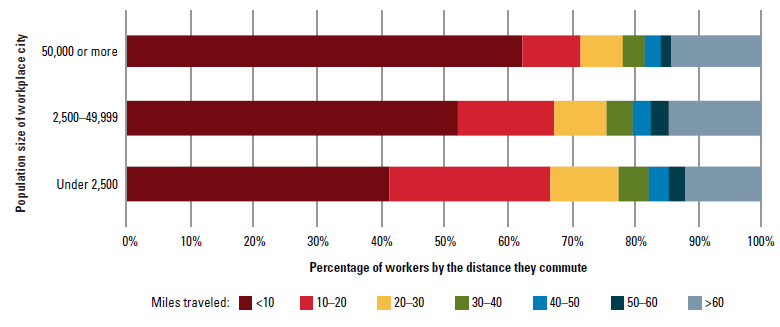No discussion of Iowa’s workforce is complete without acknowledging the intense competition for workers among Iowa communities. As the state’s industrial structure diversifies, its occupational mix diversifies as well. That translates, in some communities, to a shrinking pool of available workers for manufacturing firms and other companies with specialized needs.
Employers in small communities, drawing from a comparatively small local labor pool, may face challenges in matching open positions to available people. Commuting statistics bear this out: In Iowa’s small cities (with populations under 2,500), only 13 percent of jobs are filled by local residents. That figure jumps to 28 percent for medium-sized cities (2,500–49,999 residents) and 35 percent for large cities (50,000 or more). Statewide, only 27 percent of workers are employed within their city or township of residence.
With nearly three quarters of Iowa workers commuting across political jurisdictions, communities are in constant competition. Many cities have commissioned “laborshed” studies to define the geographic territory from which local employers are likely to compete effectively for workers. While individual city laborshed profiles have their uses, an understanding of the state’s broader commuting dynamics may prove useful for worker recruitment efforts. This article summarizes Iowa commuting patterns in 2013.
 The figure at right illustrates aggregate commuting flows by distance and workplace city size. It shows that Iowa’s largest cities draw a much higher share of their workers from within close proximity. In cities with 50,000 or more residents, 62 percent of workers live within 10 miles. Small and mid-sized cities draw only 41 percent and 52 percent of their workers from within a 10-mile radius, respectively, while relying more heavily on workers who live 10–30 miles from their jobs.
The figure at right illustrates aggregate commuting flows by distance and workplace city size. It shows that Iowa’s largest cities draw a much higher share of their workers from within close proximity. In cities with 50,000 or more residents, 62 percent of workers live within 10 miles. Small and mid-sized cities draw only 41 percent and 52 percent of their workers from within a 10-mile radius, respectively, while relying more heavily on workers who live 10–30 miles from their jobs.
The distinctions by city size tend to even out as distance increases, and most workplace locations in Iowa draw at least 80 percent of their workers from within a 40-mile radius.
Laborshed studies foster a dangerous temptation to focus on geographic reach, or “draw,” as if long commuting may prove useful for worker recruitment efforts. This article summarizes Iowa commuting patterns in 2013.
The figure below illustrates aggregate commuting flows by distance and workplace city size. It shows that Iowa’s largest cities draw a much higher share of their workers from within close proximity. In cities with 50,000 or more residents, 62 percent of workers live within 10 miles. Small and mid-sized cities draw only 41 percent and 52 percent of their workers from within a 10-mile radius, respectively, while relying more heavily on workers who live 10–30 miles from their jobs.
The distinctions by city size tend to even out as distance increases, and most workplace locations in Iowa draw at least 80 percent of their workers from within a 40-mile radius.
Laborshed studies foster a dangerous temptation to focus on geographic reach, or “draw,” as if long commuting distances by workers somehow quantify workplace desirability. Such a focus overlooks an important reality—a worker’s willingness to commute decreases rapidly with distance. Statewide commuting patterns reveal an undeniable preference among Iowans to work close to home: 56 percent of workers live within 10 miles of their workplace, while fewer than 15 percent commute more than 60 miles.
Commuting preferences may help explain some of the recruitment and retention challenges faced by Iowa employers, particularly in smaller communities. Employers who rely on distant workers face stiffer competition for those workers, especially as commuting costs to workers in time and money take their toll. Employers and communities who inflate the size of their commuting territories risk diluting their recruiting efforts with diminishing returns.
This article was written by Iowa State University economist Liesl Eathington for publication in the Spring 2016 edition of CIRAS News. To read more of that edition or other editions of CIRAS News, please check our website.